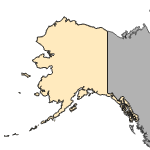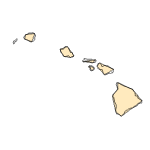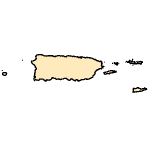Paleosuchus palpebrosus
(Dwarf Caiman)
Reptiles-Crocodilians
Exotic |
|
Common name: Dwarf Caiman
Synonyms and Other Names: Cuvier's Dwarf Caiman, Cuvier's Smooth-fronted Caiman, Musky Caiman, Wedge-head Caiman, Jacaré pagua (Portuguese)
Taxonomy: available through
www.itis.gov
Native Range: Cuvier's Dwarf Caiman is native to South America. It is most commonly found in Brazil, French Guiana, Surinam, Guyana, and Venezuela (Grenard, 1991).



|

Alaska |

Hawaii |

Puerto Rico &
Virgin Islands |

Guam Saipan |
Hydrologic Unit Codes (HUCs) Explained
Interactive maps: Point Distribution Maps
Nonindigenous Occurrences:
Table 1. States with nonindigenous occurrences, the earliest and latest observations in each state, and the tally and names of HUCs with observations†. Names and dates are hyperlinked to their relevant specimen records. The list of references for all nonindigenous occurrences of Paleosuchus palpebrosus are found here.
Table last updated 12/18/2025
† Populations may not be currently present.
Ecology: This species can be found near rivers and inundated savanna areas. It has been known to occupy streams of varying sizes, where it is spotted resting near the shorelines. This species is also terrestrial, and can be seen on piles of small rocks and, river banks, and near decaying trees. P. palpebrosus is known to dwell in burrows up to 1.5-3.5 meters long. This species prefers colder temperatures and can survive as low as 6 °C (Stevenson, 1999). Paleosuchus palpebrosus primarily feeds on fishes as an adult, although they also take insects, frogs, crustaceans, and rodents. There is little data available on the breeding habits of this species. In Colombia, they nest between August and November during the rainy season; however, it appears that nesting occurs in the dry season in Brazil. Their mound-like nests have been found on floating vegetation, but most often are on the forest floor. The female lays between 13 and 15 eggs. Incubation is 90–92 days long (Stevenson, 1999).
Means of Introduction: Pet trade.
Status: Presumed to have failed.
Impact of Introduction: The impacts of this species are currently unknown, as no studies have been done to determine how it has affected ecosystems in the invaded range. The absence of data does not equate to lack of effects. It does, however, mean that research is required to evaluate effects before conclusions can be made.
References: (click for full references)
Grenard, S. 1991. Handbook of Alligators and Crocodiles. Krieger Publishing Company, Malabar, Florida. 210 pp.
Krysko, K.L. and 12 others. 2011. Verified non-indigenous amphibians and reptiles in Florida from 1863 through 2010: Outlining the invasion process and identifying invasion pathways and stages. Zootaxa 3028:1-64.
Stevenson, C. 1999. The Paleosuchus Page. Available from: http://crocodilian.com/paleosuchus/. Accessed 3/5/2013.
Author:
Fuller, P.
Revision Date: 8/5/2022
Citation Information:
Fuller, P., 2025, Paleosuchus palpebrosus Cuvier, 1807: U.S. Geological Survey, Nonindigenous Aquatic Species Database, Gainesville, FL, https://nas.er.usgs.gov/queries/FactSheet.aspx?speciesID=2871, Revision Date: 8/5/2022, Access Date: 12/18/2025
This information is preliminary or provisional and is subject to revision. It is being provided to meet the need for timely best science. The information has not received final approval by the U.S. Geological Survey (USGS) and is provided on the condition that neither the USGS nor the U.S. Government shall be held liable for any damages resulting from the authorized or unauthorized use of the information.